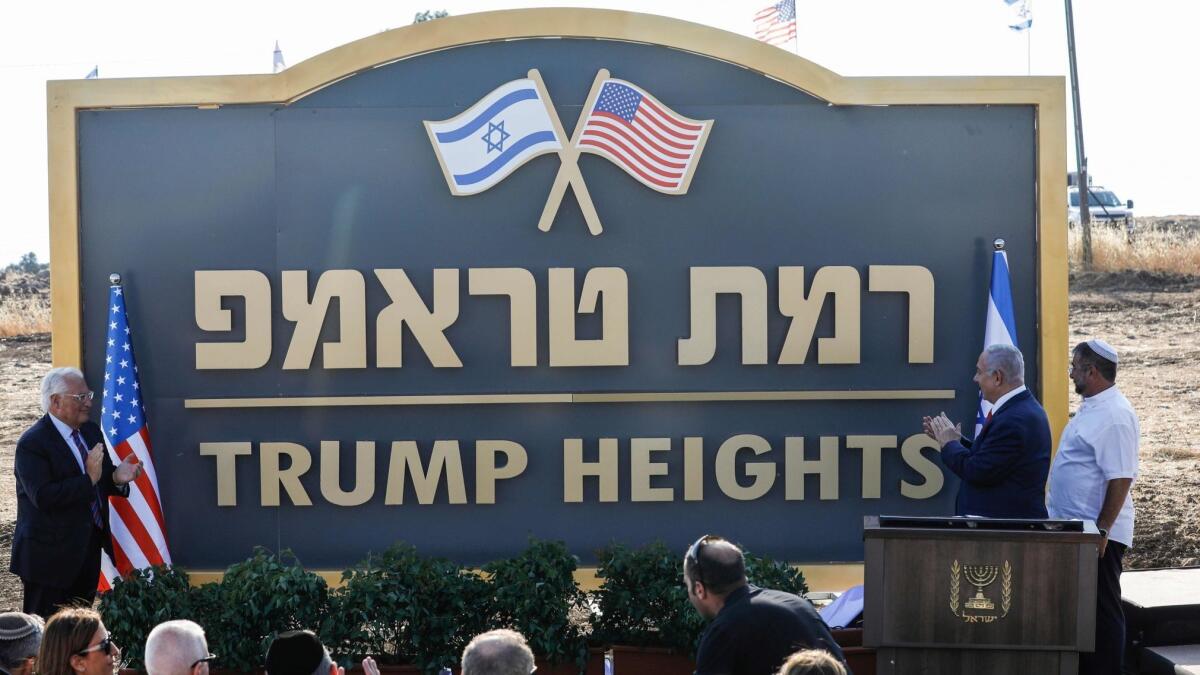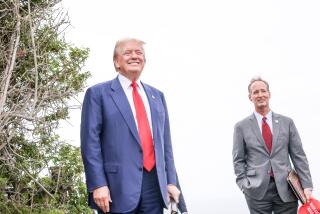Israel unveils Trump Heights, a tiny settlement of 10 ringed by high grass and land mines

Reporting from Ramat Trump, Golan Heights — The Trump name graces apartment towers, hotels and golf courses. Now it is the namesake of a tiny Israeli settlement in the Israel-controlled Golan Heights.
Israeli Prime Minister Benjamin Netanyahu’s Cabinet convened in this hamlet Sunday to inaugurate the settlement named after President Trump in a gesture of appreciation for the U.S. leader’s recognition of Israeli sovereignty over the territory.
The settlement isn’t exactly new. Currently known as Bruchim, it is more than 30 years old and has a population of 10 people.
Israel is hoping the rebranded Ramat Trump, Hebrew for “Trump Heights,” will encourage a wave of residents to vastly expand it.
“It’s absolutely beautiful,” said U.S. Ambassador David Friedman, who attended Sunday’s ceremony. Noting that Trump celebrated his birthday Friday, he said: “I can’t think of a more appropriate and a more beautiful birthday present.”
Israel captured the Golan Heights from Syria in the 1967 Mideast war and annexed it in 1981. Most of the international community considers the move illegal under international law.
But during a visit to Washington by Netanyahu in March, just weeks before Israeli elections, Trump signed an executive order recognizing the strategic mountainous plateau as Israeli territory. The decision, the latest in a series of diplomatic moves benefiting Israel, was widely applauded in Israel.
“Few things are more important to the security of the state of Israel than permanent sovereignty over the Golan Heights,” Friedman said. “It is simply obvious; it is indisputable and beyond any reasonable debate.”
After the Cabinet decision, Netanyahu and Friedman unveiled a sign trimmed in gold with the name “Trump Heights” and adorned with U.S. and Israeli flags. Trump retweeted photos Friedman posted of the event and thanked Netanyahu “and the State of Israel for this great honor!”
Addressing the ceremony, Netanyahu called Trump a “great friend” of Israel and described the Golan, which overlooks northern Israel, as an important strategic asset.
“The Golan Heights was and will always be an inseparable part of our country and homeland,” he said.
Developing Ramat Trump will not be easy. Ringed by high yellow grass and land mines, it is roughly 12 miles from the Syrian border and a half-hour drive from the nearest Israeli town, Kiryat Shmona, a community of about 20,000 people near the Lebanese border.
According to Israeli figures, almost 50,000 people live in the Golan, including about 22,000 Jewish Israelis and nearly 25,000 Arab Druze residents.
Though Israel has encouraged and promoted settlement in the Golan, its remote location, several hours from the economic center of Tel Aviv, has been an obstacle. The area is home to small agriculture and tourism sectors but otherwise has little industry.
The eight-year Syrian civil war, which at times has resulted in spillover fire into the Golan, also could present an obstacle to luring new residents.
Rosa Zhernakov, a resident of Bruchim since 1991, said the community was excited by Sunday’s decision.
“We hope it will benefit the Golan Heights,” she said, standing outside her bungalow on one of Bruchim’s few streets. She said the revitalization of the settlement will mean “more security” for residents from any possible return of the Golan Heights to Syria as part of a future peace treaty.
Syria has demanded a return of the strategic territory as part of any peace deal. After the devastating civil war in Syria, the prospects of peace talks with Israel anytime soon seem extremely low.
Vladimir Belotserkovsky, 75, another longtime resident, said he welcomed any move to build up the settlement.
“We certainly thank, and I personally am satisfied by the fact that they’re founding the new settlement named for Trump,” he said.
Ramat Trump joins a handful of Israeli places named after American presidents, including a village for Harry S. Truman, who first recognized the Jewish state, and George W. Bush Plaza, a square the size of a modest living room in central Jerusalem.
Following Sunday’s decision to rename the community, developing the settlement still requires overcoming several additional bureaucratic obstacles. With Netanyahu running for reelection in the second national election this year, it remains unclear whether he will be able to complete the task.
Zvi Hauser, an opposition lawmaker who formerly served as Netanyahu’s Cabinet secretary, called Sunday’s ceremony a cheap PR stunt.
“There’s no funding, no planning, no location, and there’s no real binding decision,” he said.
More to Read
Sign up for Essential California
The most important California stories and recommendations in your inbox every morning.
You may occasionally receive promotional content from the Los Angeles Times.










